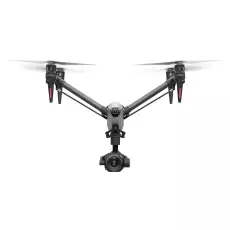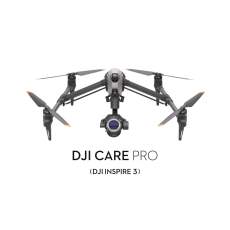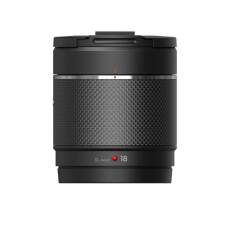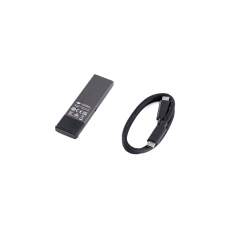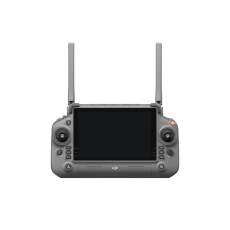In the Box:
1x Inspire 3 Aircraft
1x RC Plus
1x RC Plus Strap
1x RC Plus Waist Support
6x TB51 Intelligent Battery
1x TB51 Intelligent Battery Charging Hub
1x TB51 Intelligent Battery Charging Hub AC Cable
1x TB51 Intelligent Battery Paired Batteries Sticker
3x Inspire 3 Foldable Quick-Release Propellers (Pair)
1x USB-C to USB-C High-Speed Data Cable
1x USB-C to USB-A Data Cable
1x PROSSD 1TB
1x Inspire 3 Trolley Case
1x Zenmuse X9-8K Air Gimbal Camera
1x Zenmuse X9-8K Air Gimbal Camera Case
1x Lens Carrying Box (18/24/35/50mm)
2x Inspire 3 Gimbal Rubber Dampers
1x Double-Headed Screwdriver
3x Documents
DJI Inspire 3
General
Model
T740
Aircraft Weight
Approx. 3,995 g (includes gimbal camera, two batteries, lens, PROSSD, and propellers)
Max Takeoff Weight
Approx. 4,310 g
Hovering Accuracy Range
Vertical:
±0.1 m (with vision positioning)
±0.5 m (with GNSS positioning)
±0.1 m (with RTK positioning)
Horizontal:
±0.3 m (with vision positioning)
±0.5 m (with GNSS positioning)
±0.1 m (with RTK positioning)
RTK Positioning Accuracy (RTK fix)
1 cm + 1 PPM (horizontal)
1.5 cm + 1 PPM (vertical)
Max Angular Velocity
Pitch: 200°/s
Roll: 200°/s
Yaw: 150°/s
Max Tilt Angle
N Mode: 35°
S Mode: 40°
A Mode: 35°
T Mode: 20°
Emergency Brake: 55°
Max Ascent Speed
8 m/s
Measured when flying in a windless environment at sea level, with gimbal camera and lens attached to the aircraft and without other accessories. This data is for reference only.
Max Descent Speed
Vertical: 8 m/s
Tilt: 10 m/s
Measured when flying in a windless environment at sea level, with gimbal camera and lens attached to the aircraft and without other accessories. This data is for reference only.
Max Horizontal Speed
94 kph
Measured when flying in a windless environment at sea level, with gimbal camera and lens attached to the aircraft and without other accessories. This data is for reference only.
Max Service Ceiling Above Sea Level
Standard Propellers: 3800 m
High-Altitude Propellers: 7000 m
Measured in an environment with light wind with the gimbal camera and lens attached to the aircraft and without other accessories. This data is for reference only.
Max Wind Resistance
Takeoff/land: 12 m/s
In-flight: 14 m/s
Measured when flying at sea level, with gimbal camera and lens attached to the aircraft and without other accessories. This data is for reference only.
Max Hovering Time
Approx. 25 minutes
Measured when hovering in a windless environment at sea level with gimbal camera and lens attached to the aircraft and without other accessories, with landing gear raised, and recording 4K/24fps H.264 (S35) video until the battery reached 0%. This data is for reference only. Please refer to the actual values in the app.
Max Flight Time
Approx. 28 minutes (landing gear lowered)
Approx. 26 minutes (landing gear raised)
Measured when flying forward at a constant speed of 36 kph in a windless environment at sea level, with gimbal camera and lens attached to the aircraft and without other accessories, and recording 4K/24fps H.264 (S35) video until the battery reached 0%. This data is for reference only. Please refer to the actual values in the app.
Motor Model
DJI 3511s
Global Navigation Satellite System
GPS + Galileo + BeiDou
Propeller Model
Standard Propellers: DJI 1671
High-Altitude Propellers: DJI 1676
Operating Temperature
-20° to 40° C (-4° to 104° F)
Diagonal Distance
Landing Gear Raised: 695 mm
Landing Gear Lowered: 685 mm
Travel Mode Dimensions
Height: 176 mm
Width: 709.8 mm
Length: 500.5 mm
Gimbal Camera
Sensor
35mm full-frame CMOS
Max Resolution
Photo: 8192×5456
Video: 8192×4320
Video Resolution
View detailed list
Supported Lenses
DL 18 mm F2.8 ASPH Lens
DL 24 mm F2.8 LS ASPH Lens
DL 35 mm F2.8 LS ASPH Lens
DL 50 mm F2.8 LS ASPH Lens
Photo Format
JPG, DNG
Video Format
MOV, CinemaDNG
Operation Mode
Capture, Record, Playback
Exposure Mode
P, A, S, M
Shutter Type
Electronic shutter
Shutter Speed
8-1/8000 s
White Balance
AWB
MWB (2000K-10000K)
ISO Range
Photo
ISO: 100-25600
Video
EI: 200-6400
Anti-flicker
Capture Mode: Auto, 50 Hz, 60 Hz, OFF
Angular Vibration Range
Hovering: ±0.002°
Flying: ±0.004°
Installation Method
Quick release
Mechanical Range
Tilt:
-128° to +110° (landing gear lowered)
-148° to +90° (landing gear raised)
Roll: -90° to +230°
Pan: ±330°
Controllable Range
Tilt (landing gear lowered):
Before gimbal tilt limit extension: -90° to +30°
After gimbal tilt limit extension: -115° to +100°
Tilt (landing gear raised):
Before gimbal tilt limit extension: -90° to +30°
After gimbal tilt limit extension: -140° to +75°
Roll: ±20°
Pan: ±300°
Max Control Speed
With DJI RC Plus:
Tilt: 120°/s
Roll: 180°/s
Pan: 270°/s
With DJI Master Wheels:
Tilt: 432°/s
Roll: 432°/s
Pan: 432°/s
Weight
Approx. 516 g (without lens)
Video Transmission
Video Transmission System
O3 Pro
Live View Quality
FPV Camera: Up to 1080p/60fps
Gimbal Camera: Up to 1080p/60fps, 4K/30fps
Max Live Video Bitrate
50 Mbps
Max Transmission Distance
Single Control Mode:
FPV Camera: approx. 15 km (FCC), 8 km (CE/SRRC/MIC)
Gimbal Camera (1080p/60fps live feeds): approx. 13 km (FCC), 7 km (CE/SRRC/MIC)
Gimbal Camera (4K/30fps live feeds): approx. 5 km (FCC), 3 km (CE/SRRC/MIC)
Dual-Control Mode:
FPV Camera: approx. 12 km (FCC), 6.4 km (CE/SRRC/MIC)
Gimbal Camera (1080p/60fps live feeds): approx. 11.2 km (FCC), 5.6 km (CE/SRRC/MIC)
Gimbal Camera (4K/30fps live feeds): approx. 4 km (FCC), 2.4 km (CE/SRRC/MIC)
Measured in an unobstructed outdoor environment free of interference, with gimbal camera and lens attached to the aircraft and without other accessories. The above data shows the farthest communication range for one-way, non-return flights under each standard. During your flight, please pay attention to reminders in the app.
Lowest Latency
FPV Camera: 90 ms
Gimbal Camera: 90 ms
The lowest latency of the gimbal camera was measured when recording 4K/60fps ProRes RAW video. The lowest latency of the FPV camera was measured with strong video transmission signals.
Operating Frequency
2.4000-2.4835 GHz
5.150-5.250 GHz (CE: 5.170-5.250 GHz)
5.725-5.850 GHz
In some countries and regions, the 5.1 and 5.8GHz frequencies are prohibited, or the 5.1GHz frequency is only allowed for indoor use. Please refer to local laws and regulations.
Transmitter Power (EIRP)
2.4 GHz: <33 dBm (FCC), <20 dBm (CE/SRRC/MIC)
5.1 GHz: <23 dBm (CE)
5.8 GHz: <33 dBm (FCC), <30 dBm (SRRC), <14 dBm (CE)
Battery
Model
TB51 Intelligent Battery
Capacity
4280 mAh
Nominal Voltage
23.1 V
Type
Li-ion
Chemical System
LiCoO2
Energy
98.8 Wh
Weight
Approx. 470 g
Operating Temperature
-20° to 40° C (-4° to 104° F)
Charging Temperature
-20° to 40° C (-4° to 104° F)
If the temperature of the battery is lower than 10° C (50° F), the battery will trigger an auto-heating function. Charging in a low-temperature environment below 0° C (32° F) may shorten battery life.
Max Charging Power
411 W
Charge via Aircraft
Not supported
Battery Charging Hub
Input
100-240 V AC, max 8 A
Output
26.4 V, 7.8 A
Total Rated Output
476 W, including 65W PD fast charging of USB-C port
Charging Time
Fast Mode: Approx. 35 minutes to 90%
Standard Mode: Approx. 55 minutes to 100%
Silent Mode: Approx. 80 minutes to 100%
Tested at a room temperature of 25° C (77° F) and in a well-ventilated environment. In Fast mode, each battery pair is charged to 90% in sequence, and then eight batteries are charged together to 100%.
Charging Temperature
-20° to 40° C (-4° to 104° F)
Weight
Approx. 1,680 g
Memory Card
Memory Card Type
DJI PROSSD 1TB
Sensing
Forward
Measurement Range: 1.5-48 m
Effective Sensing Speed: ≤15 m/s
FOV:
Horizontal 90°, Vertical 103° (landing gear raised)
Horizontal 72°, Vertical 103° (landing gear lowered)
Backward
Measurement Range: 1.5-48 m
Effective Sensing Speed: ≤15 m/s
FOV: Horizontal 90°, Vertical 103°
Lateral
Measurement Range: 1.5-42 m
Effective Sensing Speed: ≤15 m/s
FOV: Horizontal 90°, Vertical 85°
Upward
Measurement Range: 0.2-13 m
Effective Sensing Speed: ≤6 m/s
FOV: Front and Back 100°, Left and Right 90°
Downward
Measurement Range: 0.3-18 m
Effective Sensing Speed: ≤6 m/s
FOV: Front and Back 130°, Left and Right 160°
Operating Environment
Forward, Backward, Left, Right, and Upward: surfaces with discernible patterns and adequate lighting (lux >15)
Downward: surfaces with discernible patterns and diffuse reflectivity >20% (e.g., walls, trees, people); adequate lighting (lux >15)
Obstacle sensing is disabled while the landing gear is in the process of being raised or lowered.
ToF Infrared Sensor Measurement Range
0-10 m
Remote Controller
Model
RM700B
Operating Time
Built-in Batteries: approx. 3.3 hours
Built-in Batteries Plus External Battery: approx. 6 hours
Operating Frequency
2.4000-2.4835 GHz
5.725 GHz-5.850 GHz
In some countries and regions, 5.1GHz and 5.8GHz frequencies are prohibited, or the 5.1GHz frequency is only allowed for indoor use. Please refer to local laws and regulations.
Video Output Port
HDMI
Power Supply
Built-in batteries or external battery
Coordinated Operation
Supports dual controls and coordination between multiple operators
Power Consumption
12.5 W
Operating Temperature
-20° to 50 °C (-4° to 122° F)
Storage Temperature
-30° to 45° C (-22° to 113° F) (within one month)
-30° to 35° C (-22° to 95° F) (one to three months)
-30° to 30° C (-22° to 86° F) (three months to one year)
Battery
Built-in Battery: 3250mAh-7.2V (a set)
External Battery: WB37 Intelligent Battery
Wi-Fi Protocol
Wi-Fi 6
Wi-Fi Operating Frequency
2.4000-2.4835 GHz
5.150-5.250 GHz
5.725-5.850 GHz
Wi-Fi Transmitter Power (EIRP)
2.4 GHz: <26 dBm (FCC), <20 dBm (CE/SRRC/MIC)
5.1 GHz: <26 dBm (FCC), <23 dBm (CE/SRRC/MIC)
5.8 GHz: <26 dBm (FCC/SRRC), <14 dBm (CE)
Bluetooth Protocol
Bluetooth 5.1
Bluetooth Operating Frequency
2.4000-2.4835 GHz
Bluetooth Transmitter Power (EIRP)
< 10 dBm
App
App
DJI Pilot 2
FPV Camera
FOV
161°
Resolution
1920×1080@60fps

